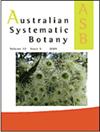Identifying evolutionary lineages in the Elaeocarpus obovatus complex: population genetics and morphometric analyses support a new subspecies, Elaeocarpus obovatus subsp. umbratilis, from northern Queensland, Australia
IF 1.6
3区 生物学
Q4 EVOLUTIONARY BIOLOGY
引用次数: 0
Abstract
Abstract. With the aim to solve long-standing problems of taxonomic delimitation within the E. obovatus species complex (E. obovatus G.Don, E. arnhemicus F.Muell., E. sp. Mt Bellenden Ker (L.J.Brass 18336) Qld Herbarium and E. coorangooloo J.F.Bailey & C.T.White), diversity and relatedness were assessed using a combined population genetics and morphometric approach among 181 and 102 individuals respectively. Simple sequence-repeat (SSR) markers were analysed with clustering methods, analysis of molecular variance (AMOVA) and STRUCTURE. The morphometric data were analysed using cluster and classification and regression tree (CART) methods. The morphometric and genetic analyses together resolve discrete groups corresponding to E. arnhemicus, E. coorangooloo, E. obovatus and E. sp. Mt Bellenden Ker. Elaeocarpus arnhemicus is clearly distinct from all other entities on most of the morphometric and genetic analyses. By contrast, E. sp. Mt Bellenden Ker and E. obovatus were not clearly separated from each other in many morphometric analyses, but can be distinguished clearly by the strongly curved pedicels in early bud and hairy ovary, and, to a lesser extent, by the frequent occurrence of two racemes per axil and cuneate leaf bases, and on the results of the genetic analyses. Elaeocarpus coorangooloo exhibits considerable genetic admixture with the other entities, but it is morphologically distinct. SSR profiles suggested that E. arnhemicus and E. obovatus may be tetraploid, whereas the other entities are diploid. This study has clarified the taxonomic limits of the currently recognised species E. arnhemicus, E. obovatus and E. coorangooloo and supports recognition of E. sp. Mt Bellenden Ker at subspecies rank, described herein as E. obovatus subsp. umbratilis Y.Baba & Crayn. A key to all taxa and revised accounts of E. arnhemicus, E. obovatus subsp. obovatus and E. coorangooloo are provided.鉴定倒卵树树复群的进化谱系:种群遗传学和形态计量学分析支持一个新的亚种——倒卵树树亚种。凤尾花,产自澳大利亚昆士兰北部
摘要为了解决E.obovatus物种复合体中长期存在的分类学划界问题(E.obova图斯G.Don,E.arnhemicus F.Muell.,E.sp.Mt Bellenden Ker(L.J.Brass 18336)Qld植物标本馆和E.coorangooloo J.F.Bailey&C.T.White),采用群体遗传学和形态计量学相结合的方法,分别对181个和102个个体的多样性和相关性进行了评估。采用聚类分析、分子方差分析和结构分析等方法对SSR标记进行分析。形态计量数据采用聚类和分类回归树(CART)方法进行分析。形态计量学和遗传学分析共同解决了与E.arnhemicus、E.coorangooloo、E.obovatus和E.sp.Mt Bellenden Ker相对应的离散类群。在大多数形态计量学和遗传学分析中,阿氏花与所有其他实体明显不同。相比之下,在许多形态计量学分析中,E.sp.Mt Bellenden Ker和E.obovatus并没有明确地相互分离,但可以通过早期芽和有毛的子房中强烈弯曲的椎弓根以及在较小程度上通过每个叶腋和楔形叶基频繁出现两个外消旋体以及遗传分析的结果来清楚地区分。蓝果胡颓和其他实体表现出相当大的遗传混合,但在形态上是不同的。SSR图谱表明,半花E.arnhemicus和倒卵E.obovatus可能是四倍体,而其他实体则是二倍体。本研究澄清了目前公认的物种E.arnhemicus、E.obovatus和E.coorangooloo的分类界限,并支持在亚种级别上对E.sp.Mt Bellenden Ker的识别,本文称其为E.obova图斯亚种。umbratilis Y.Baba&Crayn。一个关键的所有分类群和修订的记述。提供了obovatus和E.coorangooloo。
本文章由计算机程序翻译,如有差异,请以英文原文为准。
求助全文
约1分钟内获得全文
求助全文
来源期刊

Australian Systematic Botany
生物-进化生物学
CiteScore
3.10
自引率
12.50%
发文量
12
审稿时长
>12 weeks
期刊介绍:
Australian Systematic Botany is an international journal devoted to the systematics, taxonomy, and related aspects of biogeography and evolution of all algae, fungi and plants, including fossils. Descriptive taxonomic papers should normally constitute a comprehensive treatment of a group. Short papers on individual species and nomenclatural papers must contain significant new information of broader interest to be considered. The prestigious L.A.S. Johnson Review Series is published. Other review articles will also be considered. All papers are peer reviewed.
Australian Systematic Botany is published with the endorsement of the Commonwealth Scientific and Industrial Research Organisation (CSIRO) and the Australian Academy of Science.
 求助内容:
求助内容: 应助结果提醒方式:
应助结果提醒方式:


